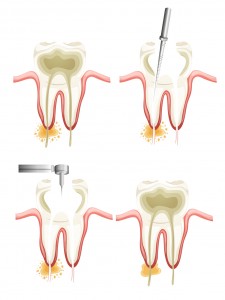 “This is going to be about as much fun as a root canal” is something you might have heard a co-worker mumble before an important meeting, or maybe you heard a friend say it before doing something they really didn’t want to do. While we can’t say that a root canal is entertaining per say, modern technology and dentistry techniques have made root canals a nearly painless and routine procedure. Do you know what really goes on, though? We’ve got the lowdown on how a root canal is performed, along with when and why they’re necessary.
“This is going to be about as much fun as a root canal” is something you might have heard a co-worker mumble before an important meeting, or maybe you heard a friend say it before doing something they really didn’t want to do. While we can’t say that a root canal is entertaining per say, modern technology and dentistry techniques have made root canals a nearly painless and routine procedure. Do you know what really goes on, though? We’ve got the lowdown on how a root canal is performed, along with when and why they’re necessary.
It’s All About The Nerves
Each tooth has anywhere from one to three roots. Dental nerves run up these roots and into the center of the tooth, into the area called the pulp chamber. When the roots and the surrounding pulp (soft tissue within the tooth) become damaged or infected due to a cavity or other decay, or an injury to the mouth, it’s necessary to remove them to stop the pain and prevent an infection or abscess from forming as the damaged tissues break down and spread bacteria.
What Does The Procedure Involve?
First, the endodontist (a specialist who works with dental nerves) will numb the tooth and surrounding area using an anesthetic. Then, a dental dam will be placed around the tooth to isolate it and prevent debris from falling into your mouth as the dentist works.
Next, the endodontist will create a hole in the top of the tooth so he or she can access the roots. Using a series of tiny files, the endodontist will scrape the insides of the tooth to remove the pulp and nerves. He or she will also periodically flush out the tooth in order to keep bacteria and debris from getting stuck in the hole.
After the pulp and nerves are removed from all the way down into the tooth’s roots, the root canals will be sealed with a rubbery substance called gutta-percha, and then a filling will be placed in the remainder of the tooth cavity.
It’s common to need a dental crown after a root canal procedure, which is done at a separate appointment. Because a large hole was made in the top of the tooth and the tooth was hollowed out, it may no longer be strong enough to withstand everyday wear and tear. A crown (also called a cap) is a metal or ceramic covering for the tooth that gives normal appearance, structure and durability back to the tooth, allowing you to chew with confidence once again.
After Care
You may experience some mild discomfort after a root canal procedure, especially in the first few hours after the anesthetic wears off. This can be mitigated with an over-the-counter pain reliever, and discomfort should subside within a few hours to a day. Until a permanent filling is in place or a permanent crown is installed, avoid chewing on the affected tooth, as it is weaker than it was and could easily break. If pain persists or if the crown or filling falls out, contact your dental office immediately for assistance.
See? A root canal isn’t all that bad! For more information about endodontal procedures or if you think you may need a root canal, feel free to leave us a message.







Leave a Reply